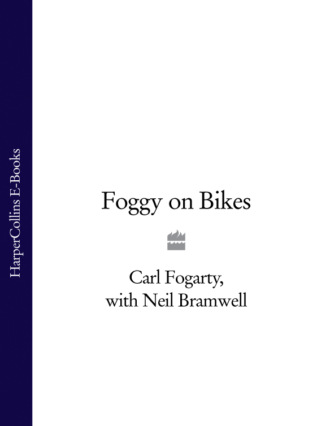
Полная версия
Foggy on Bikes
Not every rider wears his heart on his sleeve, though, like I do. Troy Corser, my team-mate in 1998 and 1999, always reminded me a lot of the Irish riders, who seemed very laid back about it all. He’s another who can do all the tricks, but when it came to riding round a track for 25 laps, he wasn’t as good as me. And the bottom line is that I would always rather be great at racing than good at tricks.
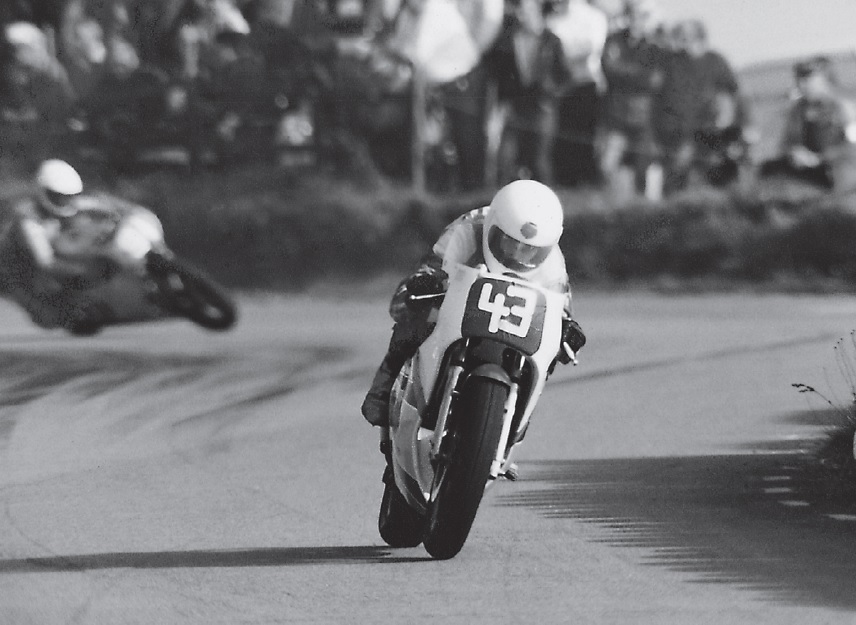
I was wearing a borrowed helmet in this club race at Darley Moor in 1985 because there had been a fire in our caravan.
Track 1Assen
NetherlandsRating: 10“All circuits should be like this! I won 12 out of 14 races here!”
There is no doubt that Assen was my favourite track. More than anywhere else, this circuit suited my riding style of being able to keep good speed through the corners. It’s a real rider’s track, with a lot of camber on the corners. And my record there is second to none. Towards the end of my career I was virtually unbeatable. From 1993 onwards I won 12 out of 14 races there, which is pretty amazing, including five double wins.
The Van Drenthe circuit dates back to 1925, so it has a rich history. I started racing there back in 1988 in the F1 TT World Championship – my first race experience abroad. Right from those early days, the omens were good. At that time, the rest of the more established Formula One teams were using quick fillers to force the fuel into their tanks and make pit-stops as quick as possible. Our lot was not that sophisticated; my main mechanic, Tony Holmes, hadn’t even travelled with us. Towards the end of the race, my mate Gary Dickinson, who wasn’t really a race mechanic at that time and was only there for a laugh, had worked out that we needed only another four litres to finish the race. While the others were filling their tanks with these contraptions, we used a jug and funnel, saved loads of time and I ended up finishing ninth, which I was pretty chuffed with. The others must have finished with half a tank full of fuel. It also meant I won £600, so for once I was able to pay our way home instead of relying on the money my dad had given us. Needless to say, we spent most of it by the time we got back to Blackburn!
Things hadn’t really run as smoothly as that, though. For a start we were placed over in the lepers’ paddock, way over on the other side to the Grand Prix teams, who were at the same meeting. There were only three of us, so whenever the weather changed we had to load different tyres onto a pole and I had to cart them over to the pit-lane myself. It was real low-budget racing.
Earlier at the same meeting, we had been warned that we wouldn’t be able to race until we controlled the noise of the bike, which was way over the protected limit. Another racer, Roger Burnett, told us about a way of getting round it by taking off the silencer and inserting a washer in the exhaust. All of a sudden, my bike went from the noisiest thing on the track to the quietest, so the stewards, who are as strict at Assen as they are anywhere, knew something was up. When they found the washer and started bollocking us, I went mad. ‘What do you want us to do? We’re just starting out and can’t afford all the stuff we’d need to meet your standards.’ They eventually let us off with a warning.
Gary must have had a thing about the stewards at Assen. Nearly 10 years later, when he was working for Sean Emmett, there was a big argument on the grid. Neil Hodgson’s bike had got some air in the clutch and the officials allowed him a minute to bleed it. Gary’s team thought he was getting special treatment, so they decided that when the time came to leave the grid, they would leave it as late as possible. When they tried it on, one of the stewards, a massive bloke, picked up Emmett’s front stand and hurled it over the barrier. The red mist came down over Gary and he smashed the bloke with his torque wrench. The following year Emmett was not allowed to race until he paid a £600 fine for what Gary had done the previous year!
Here’s a description of my flying lap around Assen. I would go through start–finish in second gear and move up to fifth through Timmer Bocht at the end of the pit-lane, where you run across a white line and a hump that can sometimes upset the bike, and straight-line it through the kink. Then I drop down two gears for the proper turn one. I enjoy this third-gear corner. You go in quite hard and then just let go of the brakes while the camber of the track holds you tight into the corner and helps you turn in. The other riders seem to keep braking all the way round. As soon as possible, just after going into the corner, I’m onto the gas and using all the room on the exit before going up through the gears to fourth and moving side to side through a couple of slight kinks left and right. This section is called Witterdiep, but they cannot really be called corners.
The next turn, Madjik, is possibly my favourite corner in racing. I go down two gears to this straightforward right-hand corner, with plenty of room going in and plenty coming out. As soon as I exit, I’m straight on the gas and can feel the bike sliding at the rear, which is a really good feeling. Then it’s up through the gears and through another dog-leg kink before getting hard on the brakes for the tight, well-banked, second-gear Osserbroeken. I exit that in second gear, climbing over the bike as I change up into third and go through another kink and under a bridge before shutting off the throttle and keeping it in third around the right-hander. More often than not I will try to run the bike in second gear through the De Strubben horseshoe, but I used to go down to first for the slowest corner on the track. That was a bit too low and upset the bike too much on the exit.
Then you are onto the back straight, the fastest part of the circuit, although it’s not technically a straight as you’re switching from one side to the other while veering slightly left all the way along. That’s characteristic of the Assen circuit. I short-shift through the gears before the first kink and get on the limiter – I never used sixth gear at Assen – before getting hard on the brakes into Stekkenwal. You have to be leaning slightly over to the left while braking, which has never been my favourite thing to do. As soon as you lift the bike up for the tight right-hander you go down into second, throw it in and exit in the same gear. I’m quickly up to third before another straightforward kink and into the banked, tight, second-gear De Bult left-hander. This is another nice, smooth corner. A few people are caught out going too fast through here and lose their front end but I have never had a problem with it. In fact, I have never ever crashed here, which is another very unusual fact.
I can then just get away with leaving the bike in second before the Mandeveen turn. Occasionally I went up into third, depending on the state of the race and whether I was trying to save the engine a little bit. I stay in second for that double right-hander. The first part is pretty straightforward before I lift the bike up a little bit, move it up to third and push it back in again into Duikersloot. It’s a bit tall, but by the time I come out into the long run towards start–finish, third gear is fine. I will leave it in fourth through the Meeuwenimeer, a very fast right-hand dog-leg. You cannot get through there flat out, you have to shut off the throttle and then move up into fifth gear through the Hoge Heide dog-leg.
The last section is all left-handers, and I move down to third through Ramshoek, although it’s hard to move quickly down through the gears here because you’re always going from one side of the track to the other. I pick up speed mid-corner through this long left-hander before the final GT Bocht chicane. This was possibly my fastest part of the circuit, a good place on the track for it. If you can get through this section quickly then you’re in a good position to get up someone, like Chili, through the chicane. Most people will run through this in first gear, I use second really well. I passed Troy Corser while in second gear in 1999 and I could tell he was still in first. However, if I have to protect my line by braking a bit later, I use first gear at this point. On the exit of the chicane I am back all over the front of the bike trying to keep the front wheel down and running across the kerb on the inside to straight-line it through start–finish.

Worst Crash: Never had one Best Moment: The double wins of 1999, my last proper racing weekend, or the double of 1995 that clinched the would championship. Closest Finish: Kocinski came past me going into the last corner, ran wide and allowed my Honda back underneath. Kocinski also allowed Corser into second. Best Other Rider: Frankie Chili. He has come from 250cc GP’s and so has a similar style to mine. Worst Moment: Being splattered by a bluebottle and losing to John Kocinski in 1997.
2 Starting to Race
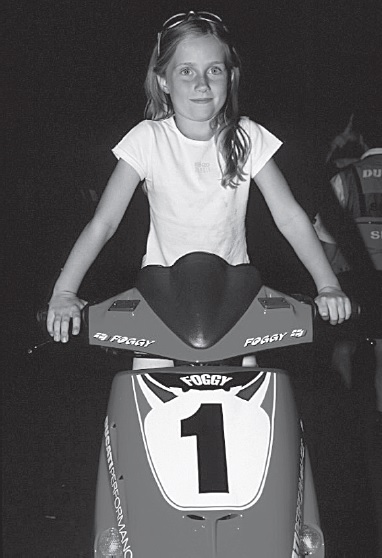
Danielle gets to grips with a Foggy replica scooter.
As a general rule, girls and bikes don’t mix. I’d be far happier if my two daughters, Danielle and Claudia – and Michaela, who has just passed her test – did not become involved. There are women who give it a go and do okay, though. The German racer Katja Poensgen has just become the first woman to compete in a 250cc Grand Prix and she seems to be beating a few of the men, which is some going.
I think it’s great that women get involved. For a start, Katja’s an attractive girl. That’s probably one of the reasons why she has got to where she is, because sponsors know they will get a lot of exposure for their team. If she was a pig in a wig, things might have been different! But there’s no question she can ride a bike, and I have seen her go very fast at times. I remember once winding up Karl Harris about her when he was riding Superstock in 1999. I asked him at a meeting how he was doing.
‘I’m doing pretty good, up there in fourth,’ he replied, forgetting to mention that Katja was second quickest.
‘What are you talking about?’ I came back. ‘You’re letting a bird beat you, you silly sod!’
I laughed, and Karl went out for the next session and went quickest! But I hope Katja does well because she has been around the World Superbike paddock for the last five years and gets on well with everyone.
There are quite a few women who also race at club level, although I’m not sure exactly how many because I don’t follow club racing. My old mechanic Anthony ‘Slick’ Bass’s new girlfriend, Juliet Manning, is part of a four-woman team racing at that level. There they are not so much at a disadvantage because on a 125cc or 250cc strength does not play a big part. There used to be a Finnish female rider, Taru Rinne, who was very fast in the 125cc GPs and probably finished in the top 10 on a few occasions in the late eighties. I think she even qualified in pole position once. It’s a different matter on a superbike or GP 500cc bike, though. There will never be a successful woman in those series, although I would like to be proved wrong. I don’t think they could ever have that aggression or ‘bastard’ attitude that some of the men have.
But it has been interesting to watch my girls starting out on bikes. Danielle has a little Yamaha TTR90 and Claudia has an old Yamaha quad that I’ve been servicing. I ordered a new plug, an on/off switch because the old one was broken, put some air in the tyres and changed the oil. When I stripped it down, and all the parts were lying around the garage, Michaela took one look at it and said, ‘Well, that thing will never run again.’
She was wrong, but she had a point. In all my time in racing, I never really had to be the one who bothered about making the bikes work, but once I had started on one bike, I tried to get a few of the others that had been standing around for years to start. The Birel had done about 10 miles at the most, yet the lawnmower-style pull-start would not work. I pulled and pulled at it until my arm ached. I took the plug out for a check, but that looked okay. I then checked there was fuel coming through, but that was fine too. I began to get really pissed off. Then, after I had charged up its battery, the Honda Cub kept cutting out after running for just a second or two.

Leading Michael Doohan in the Czech Grand Prix of 1990, while standing in for the injured Frankie Chili.
Why is it that when machines are left for twelve months they will not start? Maybe the fuel had gone a bit shitty after sitting in the carb for so long. I wanted to ring someone in Japan and drag him over for an explanation. It made matters worse that my kids were watching me fail – miserably. I don’t really have the patience, or the time, to mess around for too long before giving in and taking them down to the local bike shop. I’m not too bad on simple things like cleaning the filter of a two-stroke, but anything more complicated than that and I’m soon out of my depth.
It took some time for Claudia to gain confidence on the quad, which was strange because she is usually the one who will have a go at anything. We had to buy her a crash helmet the last time we went skiing because she goes so quickly. At one point she started crying because we wouldn’t let her go down a black run. I thought she would enjoy messing around on the quad, but she is much happier on the back with Danielle driving. Maybe it’s just that she’s not happy around machines.
Danielle was very confident on the quad, and she was soon asking if she could have a bike of her own. I wasn’t sure whether that was a good idea, but I got her the Yamaha anyway. I don’t really know where it’s all leading. After she had been on it a couple of times, I asked whether she wanted to continue on it or get a new quad, but she was adamant that she wanted to carry on riding the Yamaha. She’s actually very smooth on it, even though it’s probably a bit too heavy for her with its fat 90cc engine, which can be difficult to move around. Sure, she could get hurt on the quads, but being automatic and having four big chunky tyres means they are a lot easier to have safe fun on. And it’s an easy way for children to start riding because the throttle has a restrictor that puts a limit on how fast they can go. As they become more confident, the screw can be loosened so that the quad can reach higher speeds. With bikes it’s a different matter, and there can very easily be tears. If we had a little boy, there would be no problem with him tearing around, falling off and collecting a few scars. It’s a different matter with girls, though.
Michaela is also pretty confident riding the bikes around the field. And she was full of herself recently when she passed her road test. Mind you, she was wearing my lucky green T-shirt, so what do you expect? Seriously, though, I was convinced that she would fail because she was due to take the test on a 500cc when she had been learning on much smaller bikes. I thought that was a pretty stupid way of going about it. I sent her instructor, John Stone, a note saying, ‘Thanks for putting up with her.’ So I couldn’t believe it when she rang to say that she had passed first time. I was really proud of her. She knew she would never have been able to live it down in and around the World Superbike paddock had she failed, and said the whole experience was worse than giving birth. She won’t be going out riding on the road, but she might buy a 125cc or 250cc trail bike and come enduro riding in the Lakes. I’d be quite impressed if she could do that, although she wouldn’t be able to do the really tough stuff and would have to stick to the fireroad sections. But it just wouldn’t be her, somehow. She’s better suited to playing tennis or shopping in Manchester!
I remember the very first time my dad sat me on a bike quite clearly. He had bought me one for my ninth birthday, a bike made up by a Honda dealer called Ken Martin. It was basically a ‘monkey bike’, with a Honda 50cc engine and a chassis made up from different parts. It was a case of crash and learn. At one point, having fallen off a few times, I was convinced I would never be able to change gear. So we started again by dad putting the bike in second gear while I got used to the throttle. I opened it up and shot off down the drive, out of control! There were a couple of ornamental statues at the bottom of our garden, but they didn’t last long!
Dad let the other kids at my birthday party have a go, and one lad shot off the back when he opened the throttle too quickly. The bike did not have much to speak of in terms of top speed, but it accelerated pretty quickly. It seemed a long time before I was riding with my feet on the footrest instead of sticking them out in case I lost balance. Maybe I tried to go too fast from the start, because Danielle never seemed to have the same problems when she was learning. Perhaps she had more sense and took it more slowly, realizing she could get hurt if she fell off. Bikes do need to be respected.
The next step was obviously learning how to shut the throttle off while changing gear. But for my next birthday I was given an XR75, a four-speed bike with a clutch. I couldn’t get the hang of the clutch at all. When a bike revs loudly, or stalls, or jumps in the air, it puts you off trying. So I thought I don’t really have to use the clutch. Dad will put it in second gear and I can just let the clutch out once and ride around forever in second gear. The bottom line is confidence, and it takes a while for anyone to learn how to ride a bike. I certainly didn’t take to it like a duck to water. In no time, however, I was pulling wheelies with the older boys, my dad and his mates, and all my early problems were quickly forgotten.
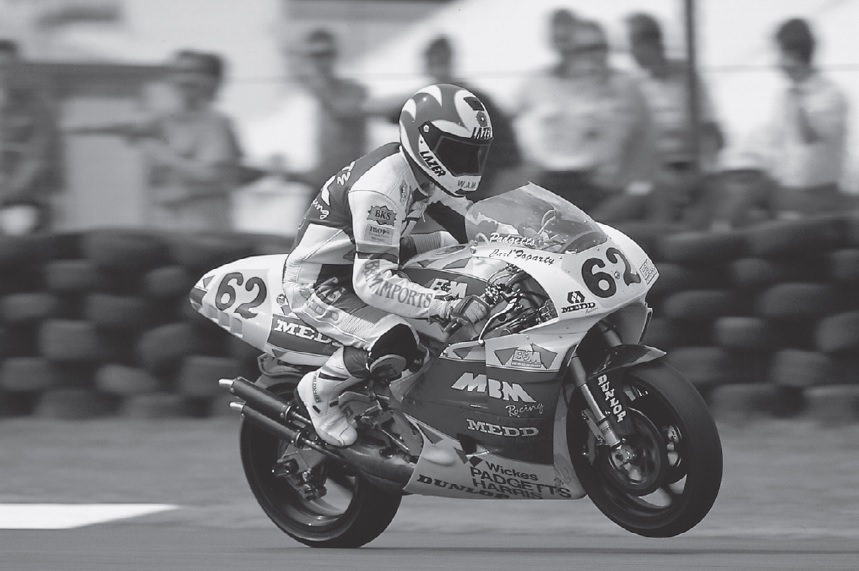
I had fifth place in the British GP of 1992 in the bag at Donington until my Harris Yamaha hit coolant that had leaked from John Kocinski’s bike.
The hardest thing for me was making that step from mucking around to actually entering my first race, which I did at the age of 15, a schoolboy motocross 125cc event in Carnforth. I was not that good at motocross but I did win every now and then, and within two years I was up against senior riders. That summer of 1983, I went to the Isle of Man, as usual, to watch Dad in what was to be his last-ever TT meeting. Immediately I realised that I had been wasting too much time in motocross and that my heart lay in road racing. This was what I knew I could be the best at. All it needed was for dad on my behalf to apply for a novice licence and enter me in a race meeting at the nearest club – Aintree, in Liverpool.
Anyone can do this by approaching their local branch of the Auto Cycle Union. Novice riders are forced to wear an orange jacket for 10 races so that the better riders know to stay clear for their own safety, but all the novices have probably been brought up riding bikes and know the basics. It would never be safe for someone to come off the street and race without any knowledge of bikes, even if they were wearing the orange jacket. When those 10 races are complete, you are free to enter club races without having to wear that jacket. It was a bit different with me, though, because I was beating people who weren’t novices from the word go.
The other way to get a head start is by going to a race school. I have just set up a Carl Fogarty race academy in conjunction with Brands Hatch and Ducati. The aim is to get riders, especially those between the ages of 12 and 18 who cannot get track time due to licence requirements, up to ACU licence stage five. That way there should be opportunities for riders to get cheaper bike insurance, and some of the best pupils will get a chance to test with Ducati’s race team, as well as British superbike support teams.
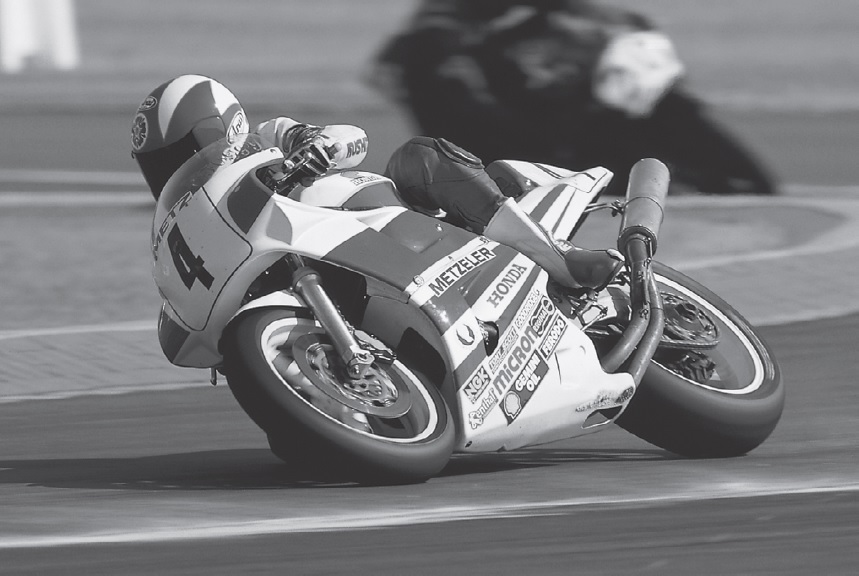
Riding the Honda RC30 on the way to my second World Formula One title in 1989, with one of the Nortons in the distance.
For the first level of training, riders must have some experience of bikes or scooters and be able to balance without aid, steer, and be able to stop and start the machine. Specific points will include the need to look ahead, throttle control and how to build a rhythm through a slow start. To test their skills, they will have to perform an extra-slow slalom, another slalom at 30mph so that they begin to appreciate weight shift and balance, and a triple hairpin to develop steering and balance control with braking and accelerating. The second level is really an extension of these disciplines for the slightly more advanced young rider. The third, though, takes on board other disciplines such as pit-lane and circuit entry, overtaking, braking, gear change and body position in corners, for riders with a full licence. Riding dynamics will be tested, as will braking performance, and in addition to another slalom course there will be riding in a circle to examine position on the bike. Again, the next level, four, is a refinement of these disciplines to get riders ready for racing in level five, after which I’ll be giving them individual tips.
It all sounds very straightforward, but sitting on a racing bike seemed like the strangest thing in the world at first. I had been used to having the handlebars sticking straight out on a motocross bike. To suddenly find myself in this strange, cramped racing position took a lot of getting used to.
Track 2Brands Hatch
Great BritainRating: 6“Brands is not one of my favourite circuits from a riding viewpoint. It was the crowd which made it so special”
Brands Hatch has always held a special place in my heart because of the amazing support I received there, but it wasn’t a circuit on which I really enjoyed racing. I was either very good or very bad there. It’s a typical British track, where a rider is on the go all the time. I could never feel relaxed at any point, as it’s not a track that flows smoothly. It’s a very demanding and challenging circuit where people really struggle on their first visit, so the British riders tend to do quite well there.
The local support is like nowhere else, and that includes Italy. The event in 1995, when I won both races in front of around 60,000 people (which was the biggest crowd at a British event for a long time), was one of the highlights of my career. And to race in front of the 120,000 fans who turned up for the 1999 round was an unbelievable feeling. That day, though, was probably one of the lowest points in my career. I desperately wanted to send everyone home happy but tyre problems ruined my first race and I had to use a different tyre for safety in the second race. The grip was awful, and I felt I’d let everyone down. That included a group of fans who would sit opposite the pits from the crack of dawn cheering my every move. It’s probably one of the worst places to watch the action from, apart from the start of the race.
I only used to touch fifth gear for a second coming through that start–finish position before braking at around the bridge before Paddock Hill. It’s a corner I enter quite quickly, running over a white line at the exit of the pit-lane to get my line. From there I drop it down two gears to third and keep the bike in tight because the corner drops away sharply, so the last thing you want to do is turn it in late. As soon as I’m over the kerb, I take the weight off the front by getting on the gas and driving down Hailwood Hill and up the other side in third gear. There might have been the odd occasion when I shifted up to fourth before dropping quickly back down.




